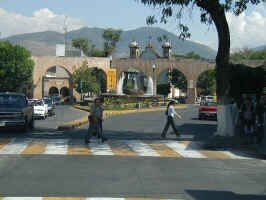October 25, 2004
Today we made the short drive to Morelia and visited the capital of Michoacan. Named after the revolutionary war hero, Jose Maria Morelos y Pavon, Morelia is a beautifully preserved colonial city with a university and an active cultural scene.
Morelia was one of the first Spanish cities built in Nueva Espana, officially founded in 1541. The buildings are beautiful and impressive and even today ordinances require new buildings to be built in the colonial style.
We wandered around town and visited the Palacio Clavijero that now houses the public offices and has wonderful murals. The building originally served as a Jesuit school but after the Jesuits were expelled from Mexico, it served as a prison and a warehouse.
| Another outstanding feature in Morelia is the aqueduct that was built between 1785 and 1788. With 253 arches stretching 2km (1.25 mi) it is an impressive sight. At the beginning of the aqueduct is a statue called the Fuente Las Tarascas. It is a lovely fountain with maidens holding aloft baskets of fruit. There is a mystery surrounding it in that in 1940 the original fountain disappeared and what is there now is a replica. A tourist official told us that a high-ranking politician took the original fountain. Hmmm. |
Leaving Morelia late in the afternoon, we found a camping spot in an old cornfield outside a small town and spent the evening watching locals herd their cows and goats home for the evening. We also saw a number of interesting birds including a Broad-billed Hummingbird and a Vermillion Flycatcher.
October 26, 2004
A short drive brought us to the outskirts of Guanajuato. Actually we’re not really sure how far the drive was. The signs along the road kept changing the mileage. Sometimes the closer we got, the further away the signs said we were. It was good for a laugh.
Guanajuato is a mining town built in 1559. It is built in a steep ravine with narrow winding streets and tunnels built underground to access various parts of the city. The outer streets were safe to drive the expedition vehicle on, and we did successfully traverse two tunnels, but we had to be very careful to not accidentally get ourselves in a position where we wouldn’t fit. As we were following directions given in a guidebook to a campground, we were flagged down by a fellow on the street who was adamant that we wouldn’t fit through the upcoming tunnel. We decided to heed his advice and follow his directions. We viewed the offending tunnel later and decided that it would have been a tight squeeze at 3.7 meters and we are 3.66 high.
| We spent the afternoon wandering the maze of streets in this amazing town. The narrow walkways and stairs and colorful paintjobs make this a fun city to walk in. A walking tour of the main plazas is a great introduction to the city. Different from other cities, Guanajuato has many small squares instead of the main large one. These make for lovely areas to watch the cities goings on. |
In addition we visited the Teatro Juarez which is a lavishly decorated building inaugurated by Porfirio Diaz, the Basilica de Nuestra Senora de Guanajuato which houses a jewel-encrusted image of the Virgin, patron of Guanajuato and the Alhondiga de Granaditas, now a museum, but originally a grain and seed storehouse built around 1800. In 1810 it became a fortress for Spanish troops who barricaded themselves inside when 20,000 troops led by Miguel Hidalgo attempted to take Guanajuato.
| On Sept. 28, 1810 a young miner nicknamed El Pipila set the great doors ablaze and allowed Hidalgo to storm the warehouse. |
A huge monument to El Pipila, burning torch held aloft, stands above the city. The view from there is magnificent. Lastly we visited the Callejon del Beso, the narrowest of the many narrow alleyways where the balconies of the houses on either side practically touch. Legend has it that the daughter of a wealthy miner was forbidden to see her common boyfriend, so he rented the room across from their home so they could steal kisses across the balconies. We’ve even put together another slide show for you to experience Guanajuato too.
October 27, 2004
| This morning we hiked down the hill from the campground to the Mina de Cata. We were unable to wrangle a tour but we did visit the small town and church next to it. While we were visiting the church we were witness to two women showing their faith and devotion by walking on their knees from the back of the church to the altar. |
Catching the bus into the center of town, we decided to visit the Museo de las Momias. This museum of mummies is a bizarre spectacle of death. Apparently the combination of the mineral content of the ground and the local atmospheric conditions stopped bodies from decaying after they were buried. It actually caused these bodies to be preserved as mummies.
Now this fact was only uncovered (ha ha) when the town officials decided to dig up bodies at the town cemetery. See when people die here, they are only allowed to rent their burial plots. Family members must continue to pay "rent" forever. When the cemetery filled up, the officials thought that the best way to keep things going was to dig up the old bodies so they could rent out the spot to someone else. Then they found the mummies.
So what do you do with hundreds of mummies, you build a museum to display them and charge people – like us – to ghoulishly view them. And yes, photography is permitted, and yes we did take photos. So when you view them, be prepared!
